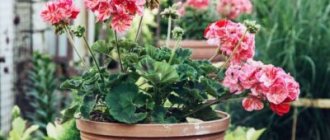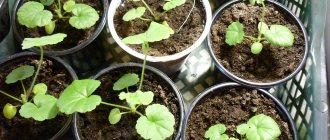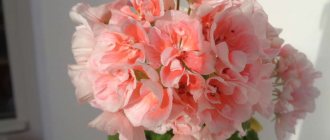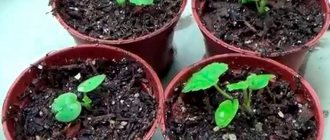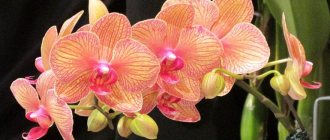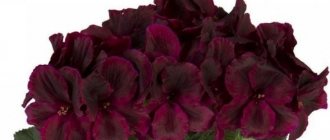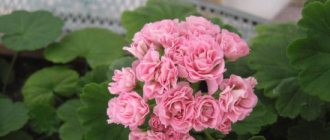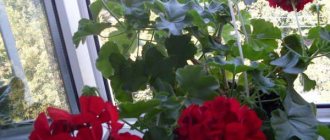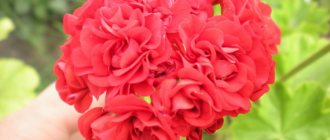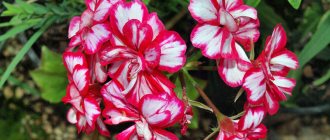Geraniums in rock garden
Since geraniums came to our gardens from different habitats: from the foothills and even mountains, from meadows, from under the forest canopy, we assign them a place in the garden in accordance with their needs and requirements.
And the first thing we will consider in more detail will be an alpine slide, rock garden, rock garden - call it what you want. Several species of geranium come from the southern foothills of the Pyrenees, Balkans and Caucasus. This is their place in the rock garden. These are, first of all, the ashen varieties - 'Laurence Flatman', 'Heather', 'Purple Pillow' and others. I'm particularly impressed by 'Purple Pillow'. And the name, translated from English as “purple pillow,” speaks for itself.
Geranium ashy 'Purple Pillow'
These varieties bloom for a very long time. For me - from June to mid-July, then there is a short (two-three week) break, and - a new wave of flowering! Just remember that these geraniums do not like acidic soil. Before planting, if you know that your soil is acidic, add dolomite flour or chalk to the hole. And don’t forget to repeat this procedure at least every other year.
And one more tip: do not plant these geraniums in the scorching sun. Let them grow so that some stone or bush covers them on the south side.
Geraniummacrorrhizum `Spessart`
On the lower tier of the hill you can plant low-growing geraniums that grow naturally in the Balkans. These are the Dalmatian geranium, the large-rhizome geranium and a natural hybrid between them - the Cantebrian geranium (G. x cantabrigiense). Moreover, both natural species and numerous varieties that have appeared on our market in recent years are good.
Geraniumx cantabrigiense 'Album'
These geraniums grow quickly and are not overly delicate. Therefore, it is better not to plant them next to alpine pearls. But to the credit of these geraniums, it must be said that a charming curtain is formed from them. Excess shoots are removed without problems and without any offense from the geraniums.
Bridgestone pelargonium
› Geranium
Colleagues, we kindly ask everyone! Please upload small photos to the forum (no more than 800 pixels on the wide side).
We will be forced to delete large photos, for example, 2000x3000 pixels by default.
BE SURE TO READ THE FORUM RULES!
Volunteer help is required in the greenhouses of the Main Botanical Garden of the Russian Academy of Sciences (Moscow, Botanicheskaya Street).
If you have the desire and time, then you can also help in this difficult matter.
Volunteers work in the garden on Mondays and one Sunday a month. Leader of the volunteer group in greenhouses: Evgeniy Gusev
,
You can contact Evgeniy to confirm the time and place of meeting on your next volunteer day. More details: https://.com/moscowtropics
Active participant
Group: Users Messages: 1120 Registration: 14.3.2014 From: Omsk
User No: 13826
Well, dear inhabitants of the forum, ladies and gentlemen, girls and boys. I finally decide to come to your court. Or rather, I’m going out but I haven’t decided yet. There have probably been attempts to open the boast a dozen times already, but something always stopped me, and I still haven’t fully decided whether you
this, and do
I
it?
Well, let it be, as they say, for the sake of history, so I will begin my leisurely story about myself, about life, about plants and other issues. Now, after the flowers have been moved to winter storage, after sorting through all the photographs, after analyzing some of my observations, I finally have time to talk with you more closely.
Therefore, I ask everyone to come and visit me, and I will try to make it interesting, easy, sometimes fun, and generally pleasant for you.
Today I want to tell you a little about myself. My name is Olga, I live in the city of Omsk, or rather outside the city, in a small village, in an ordinary apartment. My family is ordinary, classic: dad, mom, daughter, son and dog for the complete set.
There comes a time in the life of any parents when children begin to leave the parental nest. Difficult period. So, my daughter has been studying in another city for the second year for an interesting profession - architecture. Our son, thank God, is still with us, but he is 16 years old and also has a little time left. Well, let's not talk about sad things.
What do I have on my farm? Well, first of all, the dacha. It is very close, literally 12 minutes walk, that is, down to the river. There, in the former floodplain of the river, the summer cottages are located. I'll show you a little.
This is part of the alley, at the end of the alley there is a lake, which by autumn turns into a swamp, a house, a bathhouse, a vegetable garden, well, in general, everything is like everyone else. The photo was taken at different times.
Symbolic or not, this message is written under number 301.
Vegetable garden and more
Marina Chaika February 01, 2022 Category: Houseplants
Pelargonium zonal: the best varieties with descriptions
For almost a century, breeders all over the world have been breeding new varieties of pelargonium. Thanks to their efforts, an incredibly large number of different varieties and varieties of this ornamental plant were obtained.
The culture is not overly demanding in terms of growing conditions and, with proper care, will definitely respond with lush, luxurious flowering.
We bring to your attention detailed information about zonal pelargonium, as well as its best varieties (photos with names and descriptions are attached).
Diseases and pests
Pelargonium has high immunity, so pests and diseases rarely bother it. But if not properly cared for, problems can still arise.
Blooming Pelargonium Hilda
If the plant is in the wrong place or has an incorrect watering schedule, this is indicated by the following signs:
- lack of flowering;
- rusty or dried leaves;
- rotting of the root system.
It is necessary to immediately eliminate the cause of the disease and treat the plant with fungicides.
In some cases, aphids, mealybugs or whiteflies may appear on the bush. When they are detected, the flower is sprayed with insecticides.
With proper care, pelargonium will become an excellent ornamental plant with bright, unusual flowers.
https://stroy-podskazka.ru/pelargoniya/sorta/elnaryds/https://greensotka.ru/tsvetushchie/pelargoniya-elnaryds-hilda.htmlhttps://pocvetam.ru/komnatnye-rasteniya/tsvetushchie/pelargoniya-elnaryds- hilda.html
Planting and replanting Laque pelargonium
Pelargonium Laque does not like dense plantings. When planting it in open ground, do not forget about long roots, the distance between the bushes should be 20-30 cm, holes are dug to a depth of 20 cm. Planting in the soil is done in June, when the soil is no longer subject to frost.
On the windowsills in the apartment it is planted in medium-sized pots, 15-20 cm in diameter. It is better if it is a ceramic pot, it can protect the roots of the plant from high temperatures. In the absence of ceramic pots, you can plant in plastic ones, but be more careful about drying out the soil.
Note! Pelargonium begins to bloom only after the roots of the plant fill all the free space in the pot. Therefore, large containers for plants are not advisable.
Pelargonium prefers light, loose soil with a high content of sand and peat. A lack of nutrients in the soil can slow down the development of a plant and its flowering. A layer of drainage must be poured onto the bottom of the pot. Pelargonium Laque loves sunny areas, but partial shade is still preferable for it. It is advisable that the air temperature does not exceed 20-22 ° C, then flowering will be more abundant.
Important! The sand used for soil should not contain clay inclusions
How to care for PAC Viva at home
Pak Viva Madelina is a pelargonium that needs to be provided with complete and high-quality care for normal development. No special knowledge is required, but there are nuances that need to be studied.
Illumination and temperature conditions
Pelargonium April Snow - growing geraniums
This culture needs not very bright lighting. Florists advise choosing the shady part of the room. In favorable weather, the plant can be taken to the balcony to saturate it with oxygen.
To achieve lush flowering, it is recommended to maintain the temperature at +22..+26 degrees. Windows should be opened periodically to allow fresh air into the room. This will be a reliable prevention of the development of diseases and parasite attacks.
Watering rules and humidity
Too often it is not recommended to moisten the soil, as this provokes rotting of the roots. The soil should be moistened as it dries. There is no need to spray the bushes additionally. This is done only when the air is very dry.
Fertilizing and soil quality
In order for oxygen to flow into the soil better, it needs to be systematically loosened. Active fertilization is required from early spring to late autumn. The necessary compositions are sold in specialized stores and are called “for pelargoniums”.
Flower container size
A medium sized pot is suitable for the plant. It must have drainage holes through which excess moisture will be removed.
Attention! It is best to place the bush on a tray of water. This will help saturate the root system with moisture.
Pruning and replanting
The crop must be pruned annually. In this case, shoots with 4 nodes must be left intact. Thanks to this, you will be able to get a lush plant.
If dry or yellow leaves appear, they should be cut off carefully.
Important! To prevent rotting processes, the cut area should be sprinkled with charcoal. When pruning foliage, the base of the petiole should be left intact.
It is recommended to replant young plants every year. Adult bushes are moved only when the container is full. In this case, you need to place a drainage layer at the bottom and fill the container with turf, peat, humus, and leaf soil. All components are taken in equal proportions.
Pelargonium needs to be pruned in a timely manner
Planting Pelargonium Lake
Lake - pelargonium is unpretentious, but it is important to choose optimal conditions for the plant
Choosing a place and pot
Like all house geraniums, Laque prefers light areas on the south side
However, it is very important to protect the “green pet” from direct UV rays by lightly shading with tulle. A draft is unacceptable, but the crop loves fresh air, so constant ventilation must be ensured.
The pot should be selected based on the size of the bush, taking into account the fact that this geranium does not like “relocation”. Rounded models up to 15 cm in diameter and up to 20-30 cm in height look beautiful. But these dimensions are relevant for an adult plant. To plant the cuttings, you can choose a regular plastic cup.
Note! The diameter of the container should not be too large, otherwise pelargonium will begin to develop a root system, which will affect the green mass and flowering
A very beautiful plant will certainly respond to proper care and will thank the grower with stunning caps of inflorescences
Priming
A drainage layer is required, for example, from gravel, expanded clay, vermiculite. It will help prevent the roots from rotting. You can buy ready-made soil for geraniums. Or mix it yourself from turf, humus and coarse river sand.
Highfield's Ballerina
VKONTAKTE COMMUNITY
| Flowers by train! |
Sending by train is possible to all cities if there is a direct connection from Tyumen to your city!
Year-round delivery of orders to the following cities:
Astrakhan, Baku, Vladivostok, Vladimir, Volgograd, Vyazma, Yekaterinburg, Irkutsk, Ishim, Kazan, Kamensk-Uralsky, Kemerovo, Kirov, Krasnoyarsk, Makhachkala, Megion, Miass, Minsk, Moscow, Nizhnevartovsk, Nizhny Novgorod, Novosibirsk, Omsk, Penza , Pervouralsk, Perm, Rostov, Samara, St. Petersburg, Saratov, Smolensk, Sochi, Surgut, Syzran, Tobolsk, Tomsk, Ulan-Ude, Ulyanovsk, Ufa, Khabarovsk, Chapaevsk, Chelyabinsk, Chita.
NEW Baby sets on sale:Violets – 10 children at a price of 1400 rubles. together with postage (without postage 1000 rub.).
Pelargoniums – 5 pieces 1000 rub. (without postage)
In the sets, children are selected at my discretion, different in color.
SPECIAL OFFERfrom 01/08/2018
Please keep track of the sale of children, starters, divisions, adult violet plants and pelargonium cuttings
| COMMUNICATION ON THE SITE |
Good luck in growing. Alena February 06, 2022, 21:48 // Guest book –
I want to say a big thank you to Alena for the wonderful children. All so beautiful, juicy and strong. Svetlana February 06, 2022, 12:32 // Guest book –
Of course you can, email the list. Alena July 26, 2022, 07:15 // Contacts – Flower Paradise
Thank you, Lyudmila! Good luck in growing. Alena July 26, 2022, 07:15 // Guest book –
Methods for propagating a flower, when is it best to do it
The plant can be propagated in different ways. Most often, propagation is carried out by cuttings or seeds. The florist decides which method to choose.
Propagation by cuttings
For cuttings, you need to cut shoots 10 cm in size. They should have 1-2 leaves. The branches should be placed in moist soil. It should consist of sand and peat.
After 2-4 weeks, the seedlings form roots. They need to be watered as the soil dries out.
The plant can be propagated by cuttings
Attention! It is not recommended to place plants in water. This method of rooting will lead to rotting of the root system
Propagation by seeds
It is recommended to plant seeds from December to April. For this purpose, a composition based on sand and peat is used. The planting material should be buried 5 cm. The top of the container should be covered with glass or film.
The temperature should be +22..+24 degrees. After 4 leaves appear, the bushes can be replanted.
Reproduction
Pelargonium Sutarve Clara San - variety characteristics and cultivation
It is carried out in two ways - seeds and cuttings. The first option is considered the most difficult; it is almost impossible to obtain seed material on your own; they should be purchased from a reliable flower growing store. It is much easier to pick a cutting from the mother bush and root it. Sequencing:
- Carefully cut off 1-2 top shoots up to 8 cm long from the donor plant.
- Dip them in the growth stimulator "Epin".
- Plant in nutritious soil, water carefully and cover with a plastic bottle to maintain temperature and humidity.
Ventilate the sprouts every day and moisten them if necessary.
Geranium and company
But everything said is just a saying. The British, when they introduced geraniums into the garden, probably thought through everything several steps ahead! And they moved this modest inhabitant of meadows and inconveniences to the queen of all flowers - the rose! The color combinations here are generally accepted. Although I have a very calm attitude towards the queen of the garden (apparently, monarchical ideas are not close to me), I am aware that the combination, for example, of a white-flowered rose with pink or red geranium is absolutely a win-win! Roses in soft cream or light yellow shades go well with blue geraniums.
Geranium pirenaicum 'Bill Wallis'
And again, I can’t ignore my favorite small-stamen geranium. She has fuchsia flowers
Against its background, light-colored roses will look advantageous. Just remember that this “black-eyed” one is quite tall. And since she still plays the role of a retinue, then, of course, the retinue should not be higher than their mistress. And white geraniums! They will perfectly set off the depth of dark red roses. In short, geraniums and roses are absolutely the right decision! To this company, perhaps, it is worth adding soft mantle and oak sage - fortunately, a lot of varieties of the latter have been bred. And all this modest trinity - geranium, mantle and sage - are classic rose partners.
Geranium psilostemon 'Patricia'
And in tandem, where the first place rightfully belongs to the rose, and geranium performs only an auxiliary function, there are no problems in special care for geranium. Simply, in the fall, when it’s time to say to our garden: “Goodbye, see you spring!”, we cut off the leaves of deciduous geraniums and do not touch those with winter-green leaves. And we cover the roses, not thinking at all about whether our geranium will like it.
In the spring, after removing the cover from the roses, gardeners are often upset: here part of the bush is propped up, here, on the contrary, it is frozen, and here, damn them, the voles tried their best, ringing the 'Broceliande' variegation purchased only last year! Geraniums, despite the damage caused to the lady by the weather and rodents, are ready to once again fulfill the role assigned to them - to be light makeup on a beautiful young face!
As you can see, the use of garden geraniums in garden design is so diverse and multifaceted that it does not impose any restrictions on us. And this plant itself is so flexible that it will fit “in any yard” and will be in place everywhere.
Description of varieties
Among the varieties of pelargonium of the Elnaruds series, there are the most common ones.
Hilda
Compact pelargonium with lush double buds of uneven pink and white color. The leaves are yellow with a brown spot in the middle. Hilda tolerates heat well and has a long flowering period.
Gusten
A vigorously flowering variety of pelargonium Elnaryds. The inflorescences are dense, the buds are peachy-pink. The bush has a compact shape.
Variety Gusten
Bente
Zonal pelargonium. It reaches a height of 10 cm. The inflorescences are lush and double. The buds are apricot-red. Flowering of this species begins in May and continues until the end of September.
Bente flower
Otto
Otto is often used to decorate balconies and verandas. The buds of this variety are orange in color, gradually turning into soft pink. The bush reaches a height of 10 cm. Flowering begins in late spring.
A variety of flower called Otto
Singoalla
House plant with white, slightly pinkish flowers. The bush is compact and easy to shape.
Pelargonium Singoalla
Lilian
A dwarf plant with double voluminous inflorescences. The buds can be bluish-lavender in spring and pink in summer.
Representative of the Lilian variety
Clarissa
Lush bush with snow-white double flowers. The plant is compact and does not require formation.
Clarissa flower
Website about pelargoniums: photos, types, varieties, catalog
03/17/2018 by negovipr | No comments yet
Read also: How much vinegar to add to mushroom marinade
Breeder: Brian West, 2003
Double flowers in white and pink, dwarf, green leaves with a wide dark zone.
[ngg_images source=»galleries» container_ >
Add a comment Cancel reply
You must be logged in to post a comment.
In the world of flowering plants
Description of the pelargonium variety Lake and its characteristics
Pelargonium Lake is small in size, very similar to geranium. In fact, it belongs to the genus Pelargonium, which is part of the Geraniaceae family. Pelargonium Like has beautiful carved round leaves of dark green color with a wide green-brown edge.
What is Pelargonium Like
Double bright pink, milky white, orange, scarlet, peach flowers acquire a lighter shade at the edges. Small inflorescences gather into a large, dense, amazingly beautiful ball.
For your information! Pelargonium has long roots, this must be taken into account when choosing a pot for planting. It grows very quickly, forming one central stem that requires pruning.
Pelargoniums and geraniums (all about them) Collectors of geraniums and pelargoniums
I can't identify it. The label has come off. There were no “strangers”, that means “my own”, but I can’t understand who.
Wendy Read. Chameleon. The photo shows flowering in November, December and April.
Hello everybody! I’ll show you a little of mine:
Trudie – in one word “hard worker”:
Vectis Sparkler is a toy variety, a real mini, and does not require any intervention such as shaping:
March Green – this one also has quite large flowers for a stellar:
Brookside Primrose is my old favorite, the miniature flowers are very large and perfectly shaped:
Post edited by Angelina_: 06/12/2016, 23:33:32
Vectis Spider – I don’t know why, but I really love this stellar:
Bonny – this “stepka-dishevel” seems to me to be a smaller copy of the previous one, there is something attractive in its disheveled nature, and besides, it is a perfect micro-mini:
Floral Cascade is a new variety, I took it to compare with Minah's Cascade:
Mosaic Pink White:
Post edited by Angelina_: 06/12/2016, 23:35:02
Pastella - today this is the only variety from the group of royal pelargoniums that remains in my collection, even in the most difficult times I could not get rid of it, in a word - I love it!
Irene Springtime is not a new variety, but this is my first time, a very beautiful color, I would probably recognize this variety anywhere, such a color is so rare in pelargoniums:
White Butterfly is not without reason considered one of the most beautiful white-flowered varieties; the ideal flower shape is pure white with a greenish tint, not turning pink at all in the sun:
Freshfield Suki is a new variety with a slightly ugly name, but I really wanted to look at this Suki, the color of the flowers is creamy, there are not many flowers in the cap, but quite large, I will continue to watch:
Tamara is a very neat and constantly flowering variety, for lovers of white-pink and compact varieties - just what you need:
Jean Bart – ivy-leaved dianthus:
Brookside Astra - this variety in a pot never pleased me, I didn’t know how to please it, I planted it in the ground and it seems to really like it:
Pac Antic Peach is one of my firstborns, it also grows in the ground, I really like this variety for its unpretentiousness, flowering without interruption all summer:
Post edited by Angelina_: 06/13/2016, 12:53:23
Description of pelargonium varieties of the Elnaryds series
Nothing is known about the origins of Elnaryds. However, the description of popular geranium varieties from this series is worth studying in order to choose the most suitable one for yourself.
Pelargonium Elnarids Hilda
Hilda
Pelargonium Elnaryds Hilda is a dwarf variety. The petals are white in the center, turning salmon color towards the edges. Double flowers.
Gusten
Pelargonium Elnaryds Gusten is distinguished by double inflorescences. The flowers are light peach in color. The bush is compact.
Bente
The Bente hybrid grows up to 10-12 cm in height. The inflorescences are double, the shade of the petals is soft apricot turning into a rich red color.
The Otto variety is distinguished by orange-pink double-type inflorescences. Belongs to the dwarf varieties.
Lilian
The Lilian variety is characterized by lush inflorescences collected from double flowers. Petals are pale pink.
Clarissa
The Clarissa variety is distinguished by double and semi-double flowers collected in spherical inflorescences. Petals are white.
Variety Elnardis Clarissa
Geranium: a plant for all occasions in garden life
She first came to me by accident - someone gave me an ashen geranium 'Ballerina' in a pot. And somehow she didn’t make much of an impression on me. She was put on a hill (on the advice of Dr. Hession) and fell out of my sight for a whole year.
Geranium ashy 'Ballerina'
But I must say that if a plant falls into my hands, it almost always becomes a collectible. The same thing happened with geraniums. The following spring, the varietal 'Ballerina' was joined by a company of large-rhizome geranium (G. macrorrhizum), Dalmatian geranium (G. dalmaticum) and the marsh geranium I brought from a roadside ditch (G. palustre).
Geranium macrorrhizum
They all took their place in the garden and have been growing for ten years now. The following spring there were more geraniums, then even more, and by the last season the collection consisted of 80 species and varieties.
Swamp geranium (Geranium palustre)
Some species tested in my conditions did not take root. For example, the charming sessile flower (G. sessiliflorum). I really wanted this guest from New Zealand to be happy with her new place on my hill. But, unfortunately, it didn’t happen. Although I know that some colleagues live normally.
Peculiarities
This flowering plant was first discovered on the African continent and in the southern regions of Asia. Later it began to be grown in different countries of the globe.
The culture is endowed with stems that can either creep along the ground or stand upright. The stems themselves are short, for this reason pelargonium is classified as a genus of dwarf plants.
The leaves come in a variety of shapes. They are:
- ordinary and feathery elements;
- leaves that are rough to the touch and look like fingers.
The flower stalks grow in the shape of a ball, they are very thick and lush. Pelargonium flowers are small, the petals are divided into double, simple, and come in a curved configuration. The plant contains a number of essential oils, due to which it is endowed with a bright citrus aroma. It has a fairly wide range of colors. The buds can be soft pink and have rich shades such as coral tones. Pelargonium is grown in pots, flowerpots, containers, cache-pots and other containers.
You can decorate your garden, terrace or balcony with pelargonium, provided that at the slightest drop in air temperature to +5.7 degrees Celsius, the flowers will be transferred to a warm room. Usually, pelargonium is planted in flowerpots outside. It does not withstand drafts and gusty winds.
If your flower grows at home, then select rooms for it that face the south side with good lighting.
Breeders have developed a large number of different varieties and hybrids of the plant. Pelargonium is divided into groups.
- Zonal. It includes up to hundreds of tall and dwarf bushes. Among decorative flowers, pelargonium Elnaryds Alexis is considered the most popular.
- Royal. It has a tall stem, with dense bushes with double and semi-double peduncles concentrated on it.
- The crop may be an ivy-leaved plant. It got its name from the peculiar shape of the leaves, similar to ivy, and the long stems flowing down the sides of the container in which the flower is planted. The inflorescences are lush and dense brushes.
- Pelargonium is also divided into succulent and fragrant crops.
Succulent species are characterized by thick, arching stems with small leaves and large flowers.
The dwarf group includes several dozen pelargoniums, popular among gardeners. These include: Annelie, Hilda, Otto, Bente, Gusten, Lilian, Olivia, Ebon, Ljuvliga, Julia, Jazz, Alizia, Pippi, Rasken, Clarissa, Lina, Lady Molly, Windcatcher, Maestro, One of a Kind and many other names.
Pelargonium Elnaryds Alexis has proven itself well. This is a dwarf bush with bright green leaves and white flowers interspersed with pink. The shape of the flowers is very beautiful, they look like lace. This pelargonium blooms early and pleases the eye for a long time with its abundant flower stalks.
Many indoor plant lovers grow Annelie pelargonium at home. This is a bush with white and pink wavy and double buds. The flowers are medium in shape and the leaves are dark in color. It begins to bloom very early, in late May or early June.
The Hilda variety is very popular among gardeners. Dwarf bush with dark leaves. Its peduncles are dense and have a double shade. The white tone towards the center of the flower smoothly turns into salmon color. The buds are terry and rich in structure.
This dwarf tolerates the hot season well and blooms for a long time.
Otto pelargonium is planted in flowerpots to decorate gazebos or terraces. It is endowed with double orange flowers turning into a salmon tone. During the growth process, large flower caps are formed. The plant reaches 8-10 cm in height. Blooms all summer starting in May.
Elnaryds Bente is a relatively new flower, recently bred by Swedish breeders. It belongs to the type of zonal pelargonium. It rises in height by 8-10 cm. The inflorescences are very beautiful, double and lush in the middle. Most often they are a delicate apricot color, turning into a rich shade similar to red sand. Pelargonium blooms in May.
All summer you can admire the noble peduncles of this bush, until the end of September. At this time, flowering ends.
Pelargonium bridgestone
Marina Chaika February 01, 2022 Category: Houseplants
Pelargonium - description
Pelargonium (lat. Pelargonium) is a plant of the geranium family. In nature, there are up to 350 species of plants, which are usually herbaceous perennials, but there are also succulent plants and shrubs.
Homemade pelargonium is surprising in that it can have a diametrically opposite effect on people: some people feel sick from the scent of Pelargonium, while others it calms and relaxes. Only a few types of Pelargonium have been cultivated, but this does not mean that there is nothing to choose from.
In addition to their decorative qualities, Pelargoniums are also useful - they are used in medicine and perfumery. Pelargonium essential oil is used not only as a flavoring agent for soap or perfume, but is also an excellent means of purifying the air from harmful impurities and microorganisms.
Planting and caring for pelargonium (in brief)
- Flowering: from May to October.
- Lighting: bright sunlight.
- Temperature: in spring and summer – 25-30 ºC, in winter – no higher than 14 ºC.
- Watering: in spring and summer - 3-4 days after the top layer of soil in the pot dries. In winter - when the earthen ball dries to a third of its depth.
- Humidity: normal for residential premises.
- Feeding: in spring and summer - once every two weeks with mineral fertilizer for flowering plants. After flowering is completed, feeding is stopped.
- Dormant period: from November to March.
- Pruning: annually during the period until early March.
- Replanting: young plants - annually, and adults - when the roots completely entwine the earthen ball.
- Substrate: humus, leaf, turf soil and sand in equal parts.
- Reproduction: seeds and cuttings.
- Pests: whiteflies and aphids.
- Diseases: root rot, gray rot, loss of attractiveness of leaves due to improper maintenance conditions.
- Properties: some types of pelargonium are poisonous!
Read more about growing pelargonium below.
Lighting
Indoor pelargonium is one of the plants that not only tolerate direct sunlight well, but also need it. Conclusion - windows on the south side are most suitable for pelargonium.
But, despite this, the plant grows well even on the north side, the main thing is that the daylight hours are long, otherwise the shoots will stretch. In summer, pelargonium is taken out onto the street or balcony, if possible. The room with pelargoniums needs to be ventilated, because...
She needs fresh air for normal development.
Temperature
In summer, the temperature should be between 25 and 30 °C, i.e. room summer temperature. In winter, the temperature should be quite low, which is necessary for normal flowering of pelargonium. So throughout the winter, it is advisable not to rise above 14 °C.
Watering pelargonium
The pelargonium plant at home must be watered three to four days after the top layer of soil has dried. You can check by deepening your finger 1-2 cm into the substrate. It's summer.
In winter, watering is carried out in such a way that the soil does not simply dry out.
At low air temperatures and high soil humidity, the roots of pelargonium can rot, which, in turn, can lead to disease of the entire plant and its death.
Spraying pelargonium
Indoor pelargonium flowers do not suffer from dry air, so it is not necessary to spray pelargonium. If the temperature is very high in summer, then it won’t hurt to spray the leaves a little.
Feeding pelargonium
Feeding pelargonium is carried out once or twice with an interval of two weeks a couple of months after transplantation. They are fed to improve flowering, for which phosphorus fertilizers are used. Fertilizing with organic fertilizers is undesirable - the plant does not absorb them well.
Pruning pelargonium
Pelargoniums indoors are pruned annually, leaving shoots with only 2-4 nodes. This is done in order to get a lush flowering bush. In pelargonium, it is necessary to remove leaves that have turned yellow or shriveled.
To do this, use a very sharp knife, and under no circumstances tear off the leaves, since the torn edges may begin to rot. To prevent this from happening, the cut area is sprinkled with crushed charcoal.
Leaves need to be trimmed so that the base of the petiole remains on the plant.
Transplanting pelargonium
Young pelargoniums need to be replanted annually, and older pelargoniums need to be replanted when the roots completely encircle the pot. As usual, drainage is poured onto the bottom of the pot, and a soil mixture is poured on top: humus, turf and leaf soil, peat and sand - all in equal parts.
Pelargonium from seeds
When propagated by seeds, pelargoniums may lose varietal characteristics, which must be taken into account when planting. For sowing, make up a soil mixture of equal parts of peat, sand and turf soil, pour it into a low container.
For rapid emergence, the temperature should be around 22 °C, then the seeds will germinate within two weeks. Pelargonium seedlings are planted in individual small pots, and when the pot becomes small, they are transferred to pots 9 cm in diameter.
With proper care, the first flowering is observed in just over a year.
Propagation of pelargonium by cuttings
Homemade pelargonium is best propagated by apical cuttings. Cuttings are cut and rooted either at the end of winter or at the end of summer. The tip of the cutting is cut off, and the cut is made at an angle just below the node. The cuttings must have at least three leaves. Three to five leaves are best.
The cuttings are left to dry for several hours, and before planting, the cutting sites are treated with a root formation stimulator and crushed charcoal. A substrate of equal parts of turf soil, sand and peat is poured into the container, and the cuttings are planted around the perimeter. You can pinch the cuttings to make the pelargonium flower lush.
The container with the cuttings is placed in a place with bright, diffused light and the soil is regularly sprayed. After 15-20 days, the cuttings should take root. When the seedlings become stronger, they are planted in individual pots. It should be taken into account that the abundance of flowering depends on the size of the pot: the larger the pot, the sparser the pelargonium blooms.
Pelargonium will bloom 5-7 months after rooting.
Toxicity of pelargonium
Not all pelargoniums are poisonous, but it is best to wash your hands after handling the flower unless you know whether the species is poisonous.
Diseases and pests of pelargonium
Pelargonium does not bloom. If the plant is not sick or affected by pests, then this could be caused by wintering at high air temperatures and bright light.
The edges of the lower leaves of pelargonium dry out and turn yellow. Pelargonium does not have enough moisture in the soil - it is necessary to increase the frequency of watering.
The lower leaves of pelargonium wither, turn yellow and rot. Watering too often means the soil does not have time to dry out between waterings. The leaves need to be cut off and the cut area sprinkled with crushed coal powder.
The base of the pelargonium stem turns black. This is root rot. She is also “Black Leg”. Read in the “Diseases” section to learn how to deal with it.
Swellings on pelargonium leaves. Excess moisture in the soil. Pelargonium should be watered a couple of days after the top layer of soil has dried.
Gray rot on pelargonium. Pelargonium does not tolerate stagnation of water in the substrate. Improper watering - gray rot is right there!
Pelargonium pests. Whiteflies and aphids most often feed on pelargonium.
Fragrant pelargonium / Pelargonium graveolens
An evergreen, highly branched shrub, pubescent, growing up to 1 m in height. The leaves are pubescent, divided into 5-7 lobes, green. They smell nice. The inflorescences are umbrella-shaped, the flowers are numerous and pink. The flowering period is throughout the summer.
Pelargonium capitatum / Pelargonium capitatum
The species is represented by evergreen subshrubs, growing in height up to a little over 0.5 m. Shoots and leaves are pubescent. The shoots are straight. The leaves seem to be crumpled, divided into 3-5 parts, green. The inflorescence is umbellate. The flowers are sessile, grow in large numbers, and are pinkish in color (with shades of purple). Flowering period is mid to late summer. The leaves smell.
Fragrant pelargonium / Pelargonium odoratissimum
Shrub, does not shed leaves, short shoots. The leaves are up to 5 cm wide, heart-shaped, with slightly ragged edges, covered with very short and soft hairs, and smell very pleasant. The inflorescences are umbellate. Flowers are collected in 8-10 pieces, pink and white.
Pelargonium zonale / Pelargonium zonale
Evergreen meter-long subshrubs with pubescent and fleshy shoots. The leaves are usually entire and only sometimes slightly lobed, green in color with a brown border along the edge. Sessile red flowers are collected in multi-flowered inflorescences. Blooms from late spring to early autumn.
Pelargonium cucullatum
An evergreen pubescent shrub native to South Africa. Leaves on long petioles, green. The inflorescence is umbrella-shaped. The flowers are red-violet, numerous. The flowering period occurs at the end of summer - beginning of autumn. There are varieties with double leaves.
Pelargonium grandiflorum / Pelargonium grandiflorum
Evergreen meter-long shrub with a large number of branches. The leaves are either lobed or dissected, kidney-shaped, rounded, or slightly pubescent or without hairs. Up to 3 white flowers with red veins grow on a peduncle; flowers grow up to 3-4 cm in diameter. Flowering occurs in mid-spring - early summer.
Pelargonium curly / Pelargonium crispum
Evergreen shrubs with a large number of branches, grow up to 0.5 m. The leaves grow in two rows, the shape approximately resembles a heart-shaped, dense, the edges are ragged-wavy, jagged. Blooms in mid to late summer. Flowers grow on short stalks of two or three. The leaves smell nice.
Pelargonium inquinans / Pelargonium inquinans
One and a half meter evergreen shrub with fleshy shoots. The leaves are round, kidney-shaped, dark green. The inflorescences are umbellate. Pedicels are short. The flowers are red. Depending on care, it can bloom in late spring, summer, autumn and winter.
Pelargonium crithmifolium
These are succulent deciduous plants with thick creeping shoots. The leaves are divided into lobes, pinnately shaped and bluish in color, reaching 8 cm in length, and may be covered with hairs or may be hairless. The inflorescences are umbrella-shaped. Pedicels are 1.5-2 cm long, flowers grow in 5-6 pieces, white; pharynx with red spots.
Pink pelargonium / Pelargonium radens
Evergreen one and a half meter shrubs with a large number of pubescent shoots. The leaves are pubescent on both sides: with soft hairs below and hard hairs on top; the edges of the leaves are curved; the leaves are very deeply divided. They smell very nice. The peduncle is umbellate, pubescent. The flowers are pink with dark veins, growing several on a peduncle.
Angular Pelargonium / Pelargonium angulosum
Evergreen pelargonium growing up to 1 m in height. The leaves look a bit like an oak leaf, but the leaf lobes are wavy rather than straight. They grow on a short petiole. The inflorescence is umbellate. There are many flowers, most often bright red. With proper care, flowering occurs at the end of summer - mid-autumn.
Pelargonium quadrangular / Pelargonium tetragonum
This species is a deciduous shrub, growing up to 60-70 cm in height. The stems are straight, tetrahedral, light green or tinged with gray.
The leaves are heart-shaped, petiolate, covered with sparse hairs, and grow up to 5 cm wide; The edge of the leaf is reddish-brown.
The flowers usually consist of 5 white petals (with a cream or pink tint) - 3 large petals at the top, and 2 smaller ones at the bottom.
Pelargonium corymbose / Pelargonium peltatum
An ampelous evergreen shrub. Shoots are pubescent or bare. The leaves are fleshy, thyroid-shaped, shiny, green, also pubescent or glabrous, divided into five lobes, the edges are smooth. The flowers are white, pink, red, collected in groups of several in umbrella-shaped inflorescences. Blooms from mid-spring to late summer.
Sections: Houseplants, Plants on the P
After this article they usually read
Source: https://ogorod.ahuman.ru/pelargonija-bridgestone/
Necessary conditions for landing
Let's find out what requirements Lady Gertrude places on her habitat: what soil composition is important for her, the level of light, temperature and other nuances.
Location and lighting
Since the petals of this pelargonium are very delicate, direct sunlight should not affect them. And although Lady Gertrude needs good lighting, the pot with the plant should be shaded at midday. Note that with constant exposure to active sunlight on the leaves and petals, the latter become paler, the bush itself becomes smaller, looks sick, and inconspicuous.
Note! In order for the plant to bloom magnificently and develop safely, it needs about 4-8 hours of bright light per day.
It is recommended to place the container with this flower on western or eastern windowsills. The southern side with active sun and the dark northern side are not suitable for the plant. In winter, it is recommended to provide additional lighting for Gertrude so that the inflorescences form more actively.
Temperature
For the summer period, the plant is suitable for keeping at a temperature of +20-25 degrees. In winter, pelargonium needs coolness: +12-15 degrees would be the best option. Note that the plant cannot withstand heat and when the temperature rises to +30, flowering stops.
If the heat lasts for a long time, the plant may completely wither
When flowering, it is also important to prevent the petals from touching cold glass and to rid the plant of drafts. Otherwise, pelargonium will begin to drop flowers
The soil
Pelargonium Lady Gertrude prefers to grow in loose, nutritious soil. It is necessary to avoid the presence of clay inclusions in the substrate, as they greatly weigh it down. Good drainage is important for the plant.
To ensure the outflow of water from the substrate to the bottom of the pot, be sure to place a layer of expanded clay pebbles or crushed bricks. The suitable substrate composition for this pelargonium is as follows:
- turf - 1 part;
- peat soil - 1 part;
- sand - 1 part.
In addition, the soil must have a neutral or slightly acidic reaction. Pelargonium will not grow in acidified soil.
Planting a flower
When planning to plant pelargonium Elnaryds Hilda or any other variety, you need to familiarize yourself with the nuances and rules. They concern:
- Selection of soil mixture. It should contain sand, peat, humus, and compost soil in equal quantities. This is an ideal composition for young plants. For older ones, you can choose a mixture of compost, peat, humus and pine soil. Don't forget about drainage.
- Choosing a pot. A spacious container of Elnaryds Hilda pelargonium is not needed. The optimal diameter of the pot for one plant is 12-14 cm. The ideal height is 10-15 cm.
- Choosing a location. Pelargonium Elnaryds Hilda needs a lot of light, but it is necessary to avoid direct sunlight on the leaves and flowers.
Description of tulip pelargonium
After reading the description of tulip-shaped pelargonium, it is difficult to say that there are still significant points that distinguish it from other varieties. Such plants can also be either large or dwarf. Growth varies between 30 and 80 cm. The leaf blades are hard with a glossy sheen characteristic of the group. Until the plant blooms, it is difficult to determine what kind of geranium it is. This can only be done during the flowering period.
The flowers of tulip-flowered pelargonium are semi-closed, as shown in the photo of the varieties below. The bud consists of 6-9 corolla petals. They can be simple or terry. The edge of the petal is smooth or crenate. The diameter of the flower reaches approximately 1 cm or less. I will emphasize the depth of the bud. The core is several shades darker, which makes the flower seem three-dimensional.
The inflorescence can contain up to 40 half-opened buds of pink or burgundy color. The outer part of the petals has clear veins, which gives the bouquet even more decor. Some gardeners and florists use the tulip-shaped variety to create bouquets. However, when cut, the inflorescence quickly loses its neatness and fades.
Common diseases and pests
- In case of lack of nutrition, a yellowish tint begins to appear on the edges of the leaves of the plant. It is urgently necessary to fertilize it with mineral fertilizer with phosphorus and potassium. If the color turns red, this may mean that Pelargonium lacks magnesium or the temperature in the room where it is located is too low for it.
- If various swellings appear on the leaves, this means that it has been attacked by a spider mite; beige, white and yellow spots are left by aphids. Insecticidal preparations will help cope with this.
- A whitish coating on the leaves and stem indicates the presence of powdery mildew, against which fungicidal preparations are effective.
Growing problems and pests
The main pests of pelargonium are the root bug, which spoils the roots of the plant, and the whitefly, which likes to settle on the inside of the leaves. The appearance of root worms is promoted by excessive soil moisture. Insecticides are used to combat it. But in the case of damage to the root system, it is better to say goodbye to the flower and replant the cut off tops of the plant in new soil.
If you create suitable conditions for a perennial flower, it will delight you with its unique color for a long time. The main thing is not to overdo it with watering.
PAC Viva Rosita care
The container for planting PAC Viva Rosita geraniums should be large enough, at least 2 liters. Its root system does not tolerate constraint. In pots with a smaller volume, Viva Rosita dries out the buds and noticeably slows down the growth process.
This variety, unlike the prevailing opinion that pelargoniums love open sun, does not tolerate constant heat and excessive heating of the soil coma. Ideal for it would be a window sill facing east or southwest. But even here it will be necessary to take care of organizing shading from direct rays.
With the arrival of the warm season, it is better to move geraniums (if possible) to the open air. In the shade of deciduous trees on a personal plot, it will bloom and develop much better.
Regarding the temperature regime in apartment conditions, in summer you need to make sure that the temperature does not exceed 30C, and in winter, in order to ensure abundant flowering, it should be relatively low and not exceed 14C.
Viva Rosita geraniums should be watered sparingly. Each subsequent watering is carried out only after three days after the top layer of the earth has dried. These recommendations apply exclusively to the summer period. Winter watering is carried out only when the soil begins to dry out slightly.
With high humidity and low temperature in the room, the root system of the plant may begin to rot. This can have a very negative impact on the general condition of the geranium and can lead to the onset of various diseases or even its death.
It is not worth spraying pelargonium regularly throughout the year. It tolerates dry air well. But, in cases of too hot summer and, accordingly, an excessive increase in room temperature, the foliage will not have to be moistened much.
The plant needs to be fed, but only after several months after transplantation, a maximum of two times with an interval of a couple of weeks.
For feeding, you can use only phosphorus fertilizers. Adding organic compounds to the soil has no benefit, since geranium does not accept them.
Varieties of indoor plants with names and what they look like
Breeders have developed a whole group of varieties of this pelargonium. Each of them has certain advantages.
PAC Viva Madeleine
Pelargonium SOUTH Shukar, Aksinya, Ireland and other varieties
This plant variety is considered the most compact. Pelargonium Viva Madelina is characterized by dark green leaves. The shrub has neat outlines.
Flowering is typical. Pelargonium Madeline is characterized by white inflorescences with a slight pink color.
PAC Viva Carolina
The plant has large buds. They are characterized by a combination of white and lilac shades. The inflorescences have a fleecy texture. Each umbrella contains 5-6 flowers. The leaves are characterized by a typical bright green color.
PAC Viva Rosita
This culture is characterized by deep pink or coral petals. Geranium foliage has a lighter shade. A distinctive feature of the culture is considered to be lush and abundant flowering. Each inflorescence contains 5-7 buds. When they bloom, the culture looks truly luxurious.
PAC Viva Maria
A distinctive feature of the plant is the unusual color of the buds. It is characterized by a combination of white and pink tones. The white color is at the base of the petals; towards the middle it turns pink. The leaves are medium in size and rich green in color.
Important! Flowering lasts 15 days, during which the buds retain a rich shade. At the same time, the plant looks quite neat.
The color of the buds depends on the plant variety
Further care
Caring for pelargonium is not difficult even for an inexperienced gardener. It consists of timely moderate watering and loosening of the soil. Drying out of the soil or stagnation of excess water should not be allowed. Excessive watering can lead to root rot. The variety does not require spraying of leaves or additional air humidification.
Pelargonium grows independently with one stem. To give the bush a beautiful shape, pruning should be done. Then several new shoots will grow from each stem at once, and the plant will take on a beautiful shape.
Formed flower on the windowsill
With the onset of cool days in autumn, pots with plants are moved to a cooler place. The lack of lighting is compensated for by fluorescent lamps, extending the daylight hours to 10-12 hours. The air temperature should not exceed 20 °C.
Important! Fertilizing is done once a month with complex fertilizers for flowering plants.
Further care
In order for the plant to delight with elegant flowering, it is important to provide it with good care.
Pelargonium Clara Sun will be the pride of any gardener
Temperature
The optimal temperature for this variety of pelargonium is from +18 to +24 degrees; it is in such conditions that one can expect growth and beautiful flowering.
Watering and spraying, humidity
Pelargonium is afraid of swampy soil, but it is also afraid of excessive dryness. Watering is carried out as the soil dries; it is recommended to spray with a spray bottle every day in the summer, early in the morning. And in autumn, winter and early spring - no more than once a week.
To maintain optimal humidity for the plant, spray the air next to it.
Feeding
In spring, the soil is enriched with a composition containing nitrogen. During the budding period - potassium-phosphorus complexes. Late autumn and winter suggest abandoning the use of fertilizers.
Note! Organics are harmful to pelargonium because they provoke root rot.
Trimming
The main task is to make the bush compact and neat. To do this, the top is pinched; this should be done in early spring. They work with a sharp knife, the cuts are disinfected with brilliant green.
Landing
Since the crop is mainly dwarf, the pots for planting should be purchased small so that the main emphasis during the growth of the plant is not on its root part, but on the shoot located above the ground. The land for planting should contain some sand and peat.
Seeds are planted in peat boxes. The seedlings should be kept in a room with an air temperature not exceeding +20 degrees Celsius. Typically, sprouts appear 21 days after planting. During the entire period, watering must be done by irrigation from a sprayer.
After planting the plant, it must be watered once every 2-3 days. The soil should not be too wet, but it should not be too dry.
The soil needs to be fertilized periodically. Flower shops sell formulations containing nitrogen, potassium and phosphorus. They should be fed to the plant during its growing season, but not more often than 2 times a month.
When a sufficient number of leaves and flowers have formed on the bushes, you can form a “cap” from the peduncle, pinch the leaves so that the bush grows in width and has an elegant, lush peduncle.
In summer, pelargonium should receive the maximum amount of fresh air for good growth. It is recommended to take it out onto balconies, terraces, into the garden under trees, in places protected from direct sunlight. The flower tolerates temperatures above +25 degrees Celsius reluctantly.
In winter, it is recommended to keep pelargonium bushes in cool rooms with a temperature not exceeding +13 degrees Celsius. At this time of year, you need to water the crop no more than twice a month.
To learn how to grow pelargonium, see the following video.
Plant care
It also consists of several main factors:
- Watering. In summer, plants need to be watered once every 2-3 days, in winter – once a week. You can pour settled, slightly warm water into a tray and place the pot in it for half an hour. Overwatering is indicated by water pads on the leaves. If the lower green branches begin to turn yellow, this is the first sign of moisture deficiency.
- Feeding. Pelargonium Elnaryds Hilda is fertilized in the warm season with mineral and organic compounds. You can use folk remedies such as eggshells, drunk tea, and rotted manure.
- Crown formation. You can make Elnaryds Hilda pelargonium lush, compact and attractive only with timely pruning. Alternatively, simply pinch the growing points to give impetus to the development of young shoots. Pinching is carried out with the beginning of sap flow in February-March over 6-8 leaves. When pruning, old and large shoots are removed, leaving 5 buds on each branch.
- Wintering. For the winter, the pot with the plant is taken out to a cool room where the air temperature is + 10-15 °C.
- Prevention of diseases and damage by insect pests. Pelargonium Elnaryds Hilda is a hardy and unpretentious plant, but if the conditions of care are not maintained, it can be affected by diseases - fungus, rot. Systemic fungicides will help to cope with them.
